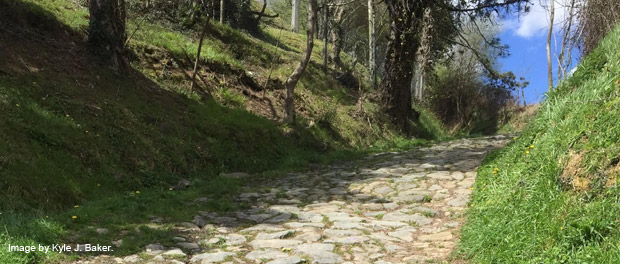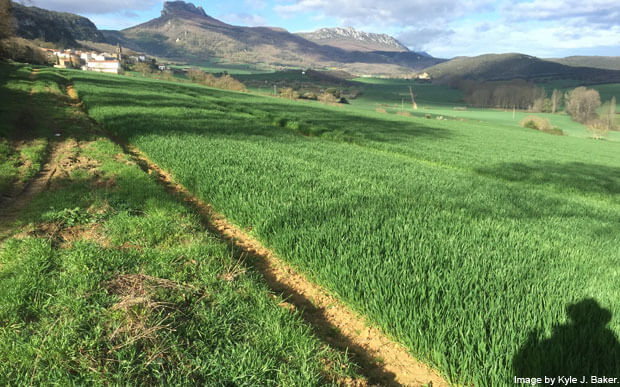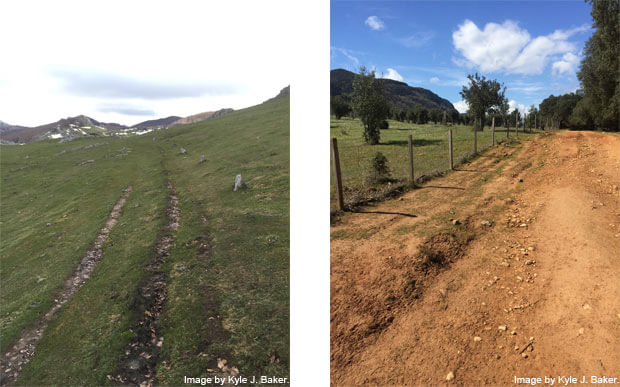 Editor’s Note: Kyle Baker is currently in Spain, walking the Camino Ignaciano, a pilgrimage path that traces the route St. Ignatius Loyola walked through Spain after his conversion in 1522. He sent this reflection from the road.
Editor’s Note: Kyle Baker is currently in Spain, walking the Camino Ignaciano, a pilgrimage path that traces the route St. Ignatius Loyola walked through Spain after his conversion in 1522. He sent this reflection from the road.
A lot of people ask why a person would choose to walk across Spain along the Camino Ignaciano. Every peregrino and peregrina (pilgrim) has his or her reasons. Most of us walk with questions, with prayer intentions (our own and those of others), and with petitions for grace, mercy, and forgiveness, as well as a desire to experience the physical world in a new way, to challenge our bodies (especially our feet), and to explore. No matter what the reason, our pilgrimages all share one thing in common: a lot of walking.
At a pilgrim’s albergue (hostel) a few days ago, a college senior from the U.S. was sitting at the end of the table I was at during the time when many people were eating dinner. These peregrinos were all doing the Camino de Santiago, as has every other pilgrim I have encountered. The Camino Ignaciano is a more seldom-traveled trail. A person from Quebec had begun a round-the-table sharing of who we were, where we were from, and why we were walking. The student said that she had signed up for a course during her last semester because she heard it included two months in Spain, but didn’t realize it would be walking across Spain! She said she was glad she did it because she had never been to Europe, but that she really didn’t like walking all that much and was going to skip the last several hundred kilometers and fly home early. She then went on to say that she didn’t like walking because it was “like the least intentional act ever.”
I looked over at the person from Quebec as tears began to well up in her eyes; she had not yet shared her reason for walking, but it was clear to me that there was one. I was still a few people away from sharing, but I couldn’t keep my mouth shut (something that will come as no surprise to those who know me well). I spoke up from down the table and said, “Sorry, but before we move on, I’d just like to say I think walking provides an opportunity for one of the single most intentional acts accessible to us, taking one step forward at a time with a purpose.”
I rambled a little bit more and mentioned that I carried my own intentions as well as the intentions of others with each step I took, and I hoped that she would get the opportunity to take at least a few intentional steps before she boarded her transatlantic flight home. Before I put my eyes back in my bowl of noodles, knowing I could have just said nothing and let the comment pass, I glanced over at my momentary friend from Quebec. A few tears had spilled over onto her cheeks, and she gently nodded to me in pilgrims’ kinship as the conversation continued around the table.
 About a month after I was baptized and confirmed into the Catholic Church, I was walking along a lakeside camp trail in Montana with a friend and mentor. I told him that I wanted to learn about what the spiritual masters from across religious traditions taught about growing closer to God. Like good mentors do, he responded to my question with a brown paper bag full of books and suggested that I start with Peace Is Every Step by the Vietnamese Buddhist monk Thich Nhat Hanh. To this day it is one of the most wonderful spiritual books I have read, and I return to it often.
About a month after I was baptized and confirmed into the Catholic Church, I was walking along a lakeside camp trail in Montana with a friend and mentor. I told him that I wanted to learn about what the spiritual masters from across religious traditions taught about growing closer to God. Like good mentors do, he responded to my question with a brown paper bag full of books and suggested that I start with Peace Is Every Step by the Vietnamese Buddhist monk Thich Nhat Hanh. To this day it is one of the most wonderful spiritual books I have read, and I return to it often.
The concept of each step in our lives being filled with opportunity to cultivate peace within ourselves and to bring peace into the world was one that aligned with the teachings of compassion, mercy, and peace that had drawn me to the Gospel. For centuries the faithful have prayed and meditated upon the final words of the beautiful Canticle of Zechariah, that the Light of Christ might “guide our feet into the way of peace” (Luke 1:79). These peaceful paths and steps are available to us in the interactions, relationships, and choices we make in life, as well as our physical interactions with the earth. Our steps leave prints on the earth as we walk, just as our larger individual and cultural actions impact our planet, which will either lead to the bearing of fruit or the reaping of famine and destruction. We see signs of both as we look around us today.
 As we process along both our physical and relational trails, whether they be in our homes or workplaces, on weekend hikes or treks around the world, let us pray that God might illuminate peaceful pathways, and that we might step with intention as we walk them.
As we process along both our physical and relational trails, whether they be in our homes or workplaces, on weekend hikes or treks around the world, let us pray that God might illuminate peaceful pathways, and that we might step with intention as we walk them.

Good morning Kyle, in my 76 years and 10 months, I have walked many unintentional steps and Our Father’s faithfulness, love and mercy never cease to overwhelm me.
Beautifully written piece, but you left me hanging. I’m waiting to hear the Good News from the beautiful valley girl who started her sentence with the word “like”! Can we pray that her path is guided by Father, Son and Holy Spirit this first Monday in July 2018? XO
Quakers talk about “Way will open” before one’s feet, step by step, as one seeks guidance or is discerning direction or just trying to live in the light of daily faithfulness to Divine Love. They say, “Don’t outpace thy Guide”, meaning I believe, don’t get ahead of where the Good Shepherd is leading, trying to do it on one’s own power or effort or by trying to see too far ahead. Stay peaceful, following one step at a time.
Your comments about the intentional steps reminded me of my reflections while I tend my garden. Weeding the vegetables, and flowers can seem tedious to some, but I meditate on removing the small imperfections in my life before they grow into large and sinful faults. This is very like removing the weeds. The careful tending allows the vegetable and flowers to grow to maturity, as removal of the little imperfections allows virtue to flourish. I try to walk 10,000 steps a day for health reasons, but I can add prayerful meditation to the reasons to walk, being inspired by the insights you have provided.
People can’t help but laugh when I tell them I collect scripture verses about feet, but your post helped clarified my reasons for doing so. Steps, paths, stumbling, being guided…You write of the intentional act of walking,”taking one step forward at a time with a purpose.” I’ll remember that.